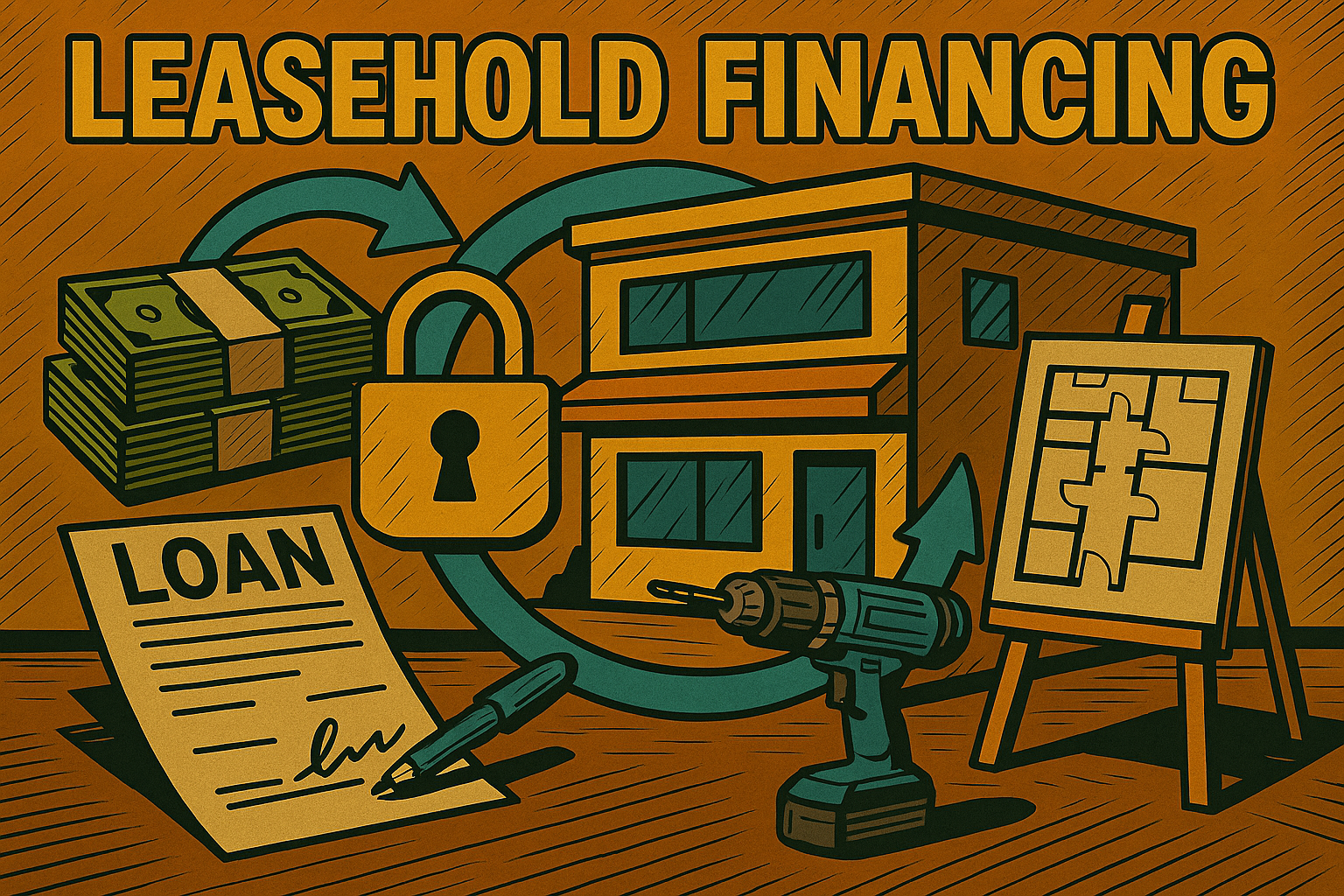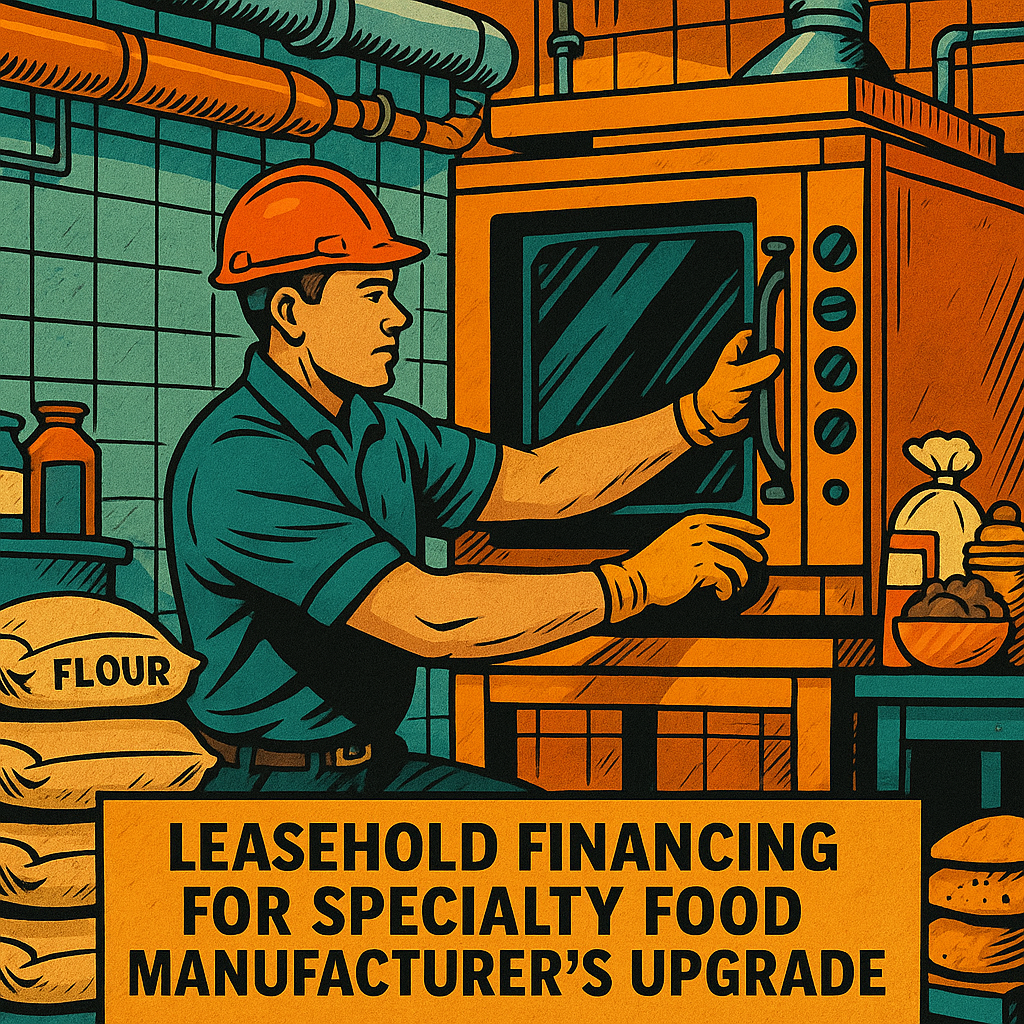
Leasehold Financing
“Fit-Out Funds, No Deed Required.”
Unlocking the Value of Your Lease – Without Owning the Property
Leasehold financing (a.k.a. leasehold improvement financing or tenant improvement financing is a type of commercial loan used to fund:
- Tenant improvements (renovations, interior construction, or fit-outs)
- Specialized equipment installed in leased premises
- Relocation or expansion costs tied to a new lease
The funding is secured by a business’s leasehold interest – the legal right to occupy and use the property under the terms of a premises lease – along with other security like business assets or personal guarantees…without needing to own the underlying property. Instead of leveraging real estate, the loan is supported by the value created through the leasehold interest and the assets or revenue potential tied to it.
Owning property isn’t always feasible or strategic, but your business location still plays a critical role in customer traffic, brand perception, and operational efficiency. Leasehold financing can:
Accelerate Growth – Move into a prime location or expand faster.
Preserve Working Capital – Avoid draining cash reserves for build-outs.
Enhance Value – Create a better customer experience and operational workflow.
Leasehold Financing Example: Dental Office Modernization
Scenario:
A dental practice wants to modernize its waiting room and operatories to attract higher-end clients, but it doesn’t own the building.
Financing Need:
$400,000 for new dental chairs, digital imaging equipment, and interior renovations.
How Leasehold Financing Helps:
The lender secures the loan with the practice’s leasehold improvements and personal guarantee.
Patient traffic increases by 20% within the first year.
The upgraded image supports higher service pricing, lifting profit margins.

Leasehold Financing Example: Specialty Food /Bakery
Scenario:
A small-batch bakery leases a light industrial unit but needs specialized ovens, HVAC, and food-safe flooring to scale production.
Financing Need:
$280,000 for equipment installation and facility upgrades.
How Leasehold Financing Helps:
Leasehold loan covers infrastructure improvements while preserving working capital for ingredient sourcing.
Production output increases by 40%, enabling expansion into wholesale accounts.

How Leasehold Financing Works
Loan Application
- You submit a formal application, including recent business financial statements, tax returns, a detailed business plan, and cost estimates for the planned improvements or equipment.
- This is the stage where you demonstrate your business has both the capacity and strategy to make the improvements successful. A well-prepared application speeds up approval and positions you for better terms.
Lease Review
- The lender examines your lease agreement in detail. They want to ensure the lease term matches—or preferably exceeds—the loan term.
- They also verify any renewal options and check for clauses that could cause early termination.
- A mismatch between lease and loan terms is a major red flag for lenders.
Landlord Consent
Purpose: Confirms the landlord is aware of and approves of the financing and the tenant’s planned improvements.
Key Elements:
– Permission for improvements to be made.
– Assurance that the lease terms allow financing.
– Recognition that the lender has an interest in the leasehold improvements.
Landlord Waiver (or Subordination Agreement)
Purpose: Protects the lender’s rights to collateral if the tenant defaults or the lease ends early.
Key Elements:
– Landlord agrees not to seize, lien, or block removal of financed equipment or improvements.
– Lender may have the right to enter the premises to repossess certain assets (e.g., equipment).
– Prioritization of lender’s claim over landlord’s claim on tenant-installed assets.
– Sometimes includes the right for the lender to assign the lease to another tenant (subject to landlord approval).
Funding & Improvements
- Once approved, loan proceeds are disbursed—either as a lump sum (term loan) or in drawdowns (line of credit).
- Funds are used for specific, pre-approved purposes: interior build-outs, equipment installation, or infrastructure upgrades.
- Lenders typically require proof of completion for major work stages. (this ensures lender confidence by verifying that capital is used to enhance the business location, not unrelated expenses).
Repayment
Payments are scheduled as either:
▪ Term Loan: Fixed monthly payments over the loan period.
▪ Line of Credit: Withdrawals (funds disbursement) with interest-only payments during the draw period, followed by amortized repayment.
Lines of Credit That Convert to Term Facilities
How It Works:
- Draw Period:
- During the build-out or improvement phase, the lender extends a line of credit (sometimes called a “draw-line”).
- The borrower draws funds as needed to pay contractors, purchase materials, or install equipment.
- Payments during this phase are often interest-only, keeping early costs low.
- Conversion to Term Loan:
- Once the project is completed (and sometimes after a short “stabilization” period), the outstanding balance on the line of credit automatically converts to a fully amortizing term loan.
- Repayments then include both principal and interest, typically on a fixed monthly schedule aligned with the lease term.
Why Lenders Like This Structure:
- Reduces unused capital costs because borrowers only pay interest on drawn amounts during the build-out.
- Allows close oversight of project progress before locking into a long-term repayment structure.
- Improves loan performance tracking by having a predictable amortization schedule post-conversion.
Why Borrowers Like It:
- Frees up cash flow in the early months while improvements are underway and the upgraded space isn’t yet generating full revenue.
- Provides flexibility for project changes during construction.
- Smooth transition to stable, predictable payments once the business is fully operational in the improved space.

Best Practices for Leasehold Financing Success
Leasehold financing can be a powerful growth tool — but only if structured carefully.
Negotiate Lease Terms That Support Long-Term Stability
- Why It Matters: A loan is only as secure as the lease that underpins it. If the lease ends before the financing is repaid, both borrower and lender are exposed to major risk.
- What to Do:
- Negotiate for a lease term (including renewal options) that matches or exceeds the financing term.
- Ensure the lease allows assignment or subletting in case of sale or relocation.
- Push back on restrictive clauses that could prevent renovations or financing.
- Tip: A longer lease with renewal rights gives lenders confidence and gives your business a stable foundation for growth.
Build a Realistic Budget — With Contingencies
- Why It Matters: Renovations and improvements almost always cost more and take longer than expected. Overruns can drain working capital and strain repayment capacity.
- What to Do:
- Get multiple contractor quotes and include line-item detail in your financing request.
- Add at least 10–15% as a contingency buffer for unexpected expenses.
- Include soft costs like permits, design fees, and utility upgrades in your budget.
- Tip: Presenting a detailed and conservative budget improves credibility with lenders and reduces surprises mid-project.
Maintain Transparent Communication with Both Landlord and Lender
- Why It Matters: Both parties have vested interests in your success. Landlords want improvements that increase property value; lenders want to ensure loan repayment.
- What to Do:
- Keep both landlord and lender updated on project milestones, timelines, and any delays.
- Secure landlord consent and, where required, a landlord waiver early to avoid last-minute financing holdups.
- Document all communications and agreements to protect yourself from disputes.
- Tip: Acting proactively reduces friction, builds trust, and often accelerates approvals.
Ensure Improvements Drive Revenue Growth or Cost Savings
- Why It Matters: Leasehold improvements should strengthen business performance, not just aesthetics. Financing is justified only if the upgrades pay for themselves.
- What to Do:
- Tie each improvement to a measurable outcome:
- More seating = higher customer throughput.
- Modernized equipment = reduced downtime.
- Layout redesign = increased efficiency.
- Track KPIs (ROI, revenue per square foot, customer traffic) before and after improvements.
- Tie each improvement to a measurable outcome:
- Tip: Lenders respond favorably when you can show a direct link between improvements and cash flow growth — it signals lower repayment risk.
Final Takeaway
Leasehold financing bridges the gap between leasing space and owning it—allowing you to invest in your business environment without tying up large amounts of cash. When structured well, it’s a powerful tool for growth, brand development, and operational efficiency. But it requires careful planning to ensure the financing term, lease agreement, and business performance all work in harmony.
💡 Bonus: Performance Metrics & Monitoring
Once leasehold financing is in place and the improvements are complete, the real work begins – measuring whether those upgrades are paying off. Both lenders and business owners benefit from tracking clear performance indicators.
Business Owner KPIs
ROI on Improvements
- Definition: The percentage return generated by the improvements compared to the total financing cost.
- Why It Matters: ROI confirms whether the capital invested in the build-out, renovations, or equipment is generating enough additional profit to justify the loan.
- How to Track:
- Calculate total improvement cost (loan amount + interest + other related expenses).
- Measure the increase in net profit over a defined period (often 12–24 months).
- ROI = (Annual Net Profit Increase ÷ Total Improvement Cost) × 100.
- Tip: A high ROI strengthens your negotiating position with landlords and lenders for future expansions.
Revenue per Square Foot (Before/After Improvements)
- Definition: Sales revenue divided by the usable floor space of your location.
- Why It Matters: This is a retail and service industry staple—it shows how efficiently space is being used to generate income.
- How to Track:
- Take monthly or quarterly sales figures before and after improvements.
- Divide by total usable square footage.
- Compare the before-and-after figures to assess uplift.
- Tip: Even small increases in revenue per square foot can have a big impact on profitability over time, especially in high-rent areas.
Customer Traffic Changes
- Definition: The change in the number of customers visiting your location before and after improvements.
- Why It Matters: Many leasehold improvements—better layout, modern finishes, expanded seating—are designed to boost footfall. More customers usually means more revenue.
- How to Track:
- Use point-of-sale (POS) system data, door counters, or even mobile analytics to track visits.
- Compare data in similar seasonal periods to account for fluctuations.
- Tip: Pair traffic counts with average transaction value to see if you’re not just attracting more people, but also higher-spending customers.

